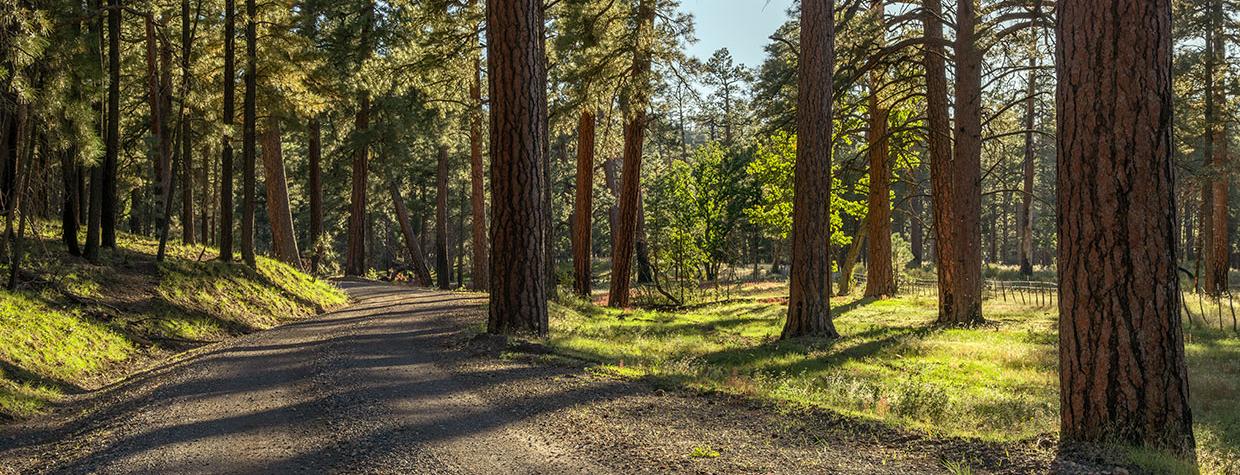Millions of people find their way to the Grand Canyon every year, and most of them follow paved roads to get there. That’s understandable: Arizona’s most famous natural wonder isn’t that close to many places, and sometimes, you just want to get the journey done. But if you’re willing to take a little longer, Forest Road 307, a well-maintained side road east of the developed South Rim area, offers diverse flora, interesting geology and a chance for relative solitude on your way to the Canyon.
This drive begins west of Cameron on State Route 64, the main route to the South Rim from the east. Head south on FR 307, a gravel Kaibab National Forest path that immediately bends to the west and parallels SR 64 for a bit. While doing so, it passes through Lee Canyon and a landscape of junipers, piñon pines and sagebrush, but what you’re also likely to notice is the row of rounded buttes, covered with evergreens, on the south side of the road.
Collectively, these buttes form the Coconino Rim, an escarpment that rises some 1,000 feet over this relatively flat area. The landform runs generally southeast from the Desert View area of the South Rim to Gray Mountain, on the Navajo Nation. And it’s an important feature of a roughly 70-square-mile area known as the Upper Basin, which is known for its biodiversity: A 2010 study documented nearly 400 different plant species there.
You’ll see some of that diversity at Mile 3, when FR 307 reaches a lovely clearing that might be filled with wildflowers in spring and summer. Keep your eyes open for elk and mule deer, too. At Mile 5.5, you’ll come to another clearing, this one much larger than the first, and enjoy a wide view of the Coconino Rim and more wildflowers along the road.
Next up, around Mile 8, is an area of burned trees, but it lasts less than a mile before a healthy forest returns, this time with ponderosa pines joining the piñons and junipers. You’ll curve through a relatively shallow canyon, giving you an up-close look at some interesting rock formations on both sides of the road, before reaching one of the road’s only rough and rocky sections at Mile 10. In good weather, most passenger cars can navigate this stretch, but you’re likely to be more confident in an SUV.
By Mile 11, FR 307 has smoothed out and begun dipping in and out of canyons filled with oaks and tall ponderosas. Two miles later, you’ll come to the side road to Hull Cabin, the area’s oldest historic cabin — it dates to the late 1880s, when it was part of a sheep ranch. Today, the rustic cabin is available for overnight stays, generally from May through September, through the U.S. Forest Service’s Rooms With a View program.
FR 307 now climbs for a half-mile or so, and past the steep drop-off on the left, you’ll get a fleeting view of the forested landscape to the east. It’s another half-mile to an Arizona Trail crossing, and just beyond that, you’ll reach an intersection with Forest Road 310. If you have a high-clearance vehicle, turn right and follow this very rutted road for 1.4 miles to SR 64 inside Grand Canyon National Park — passing another historic structure, the 1936 Grandview Lookout Tower, along the way. But if you don’t have such a vehicle, there’s nothing wrong with going back to SR 64 the way you came. The Canyon will still be there whenever you arrive.
tour guide
Note: Mileages are approximate.
Length: 15.7 miles one way (from State Route 64)
Directions: From the intersection of U.S. Route 89 and State Route 64 in Cameron, go west on SR 64 for 20.4 miles to Forest Road 307. Turn left onto FR 307 and continue 14.3 miles to Forest Road 310. Turn right onto
FR 310 and continue 1.4 miles to SR 64 inside Grand Canyon National Park.
Vehicle requirements: A high-clearance vehicle, such as an SUV or truck, is recommended for FR 307 and required for FR 310.
Special consideration: If entering Grand Canyon National Park via FR 310, National Park Service fees apply and can be paid at the South Entrance Station or the Desert View Entrance Station.
Warning: Back-road travel can be hazardous, so be aware of weather and road conditions. Carry plenty of water. Don’t travel alone, and let someone know where you are going and when you plan to return.
Information: Tusayan Ranger District, 928-638-2443 or fs.usda.gov/kaibab; Grand Canyon National Park, 928-638-7888 or nps.gov/grca

